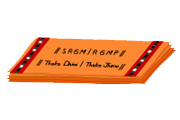Lyrics and Meanings (Ashtapadi)
Aṣhṭapadhi - It is lyrical poetry in 12 chapters, which is further sub-divided into 24 divisions called Prabandhha. Each Prabandhha is again sub-divided into two, comprising eight couplets called Aṣhṭapadhis.view more
Lyrics and Meanings (Ashtapadi)
Aṣhṭapadhi - It is lyrical poetry in 12 chapters, which is further sub-divided into 24 divisions called Prabandhha. Each Prabandhha is again sub-divided into two, comprising eight couplets called Aṣhṭapadhis.
Each song of the Aṣhṭapadhiis set in a special rāga and thāḷa. It is a rhyme of eternal love and supreme devotion. The literal meaning of "Aṣhṭapadhi" is "eight steps".
Gītha Govindha composed in the 12th century by Indian poet Jayadheva in Sanskrit language is a lyrical poetry in twelve chapters, sub-divided into twenty four divisions called Prabandhha. The songs in Gītha Govindha symbolize the eternal love of Lord Kriṣhṇa and his beloved Rādhhā and the sublimation of love in God through complete surrender.
Chapter one and chapter two, four, five and twelve contain two Aṣhṭapadhis each; chapters three, six, eight, nine and ten contain only one Aṣhṭapadhi each. Thus there are twenty-four Aṣhṭapadhi. These Aṣhṭapadhis can be set to music in different melodious ragas, which were appreciated and followed by the poets later period. On which more than hundred commentaries has been written in Sanskrit and over fifty more than hundred commentaries have been written in Sanskrit and over fifty in regional languages in India also in many foreign languages.
Since the Gīthagovindha was composed specifically for dance performance during the night worship of Lord Jagannātha, the composition is so deftly made as to be sung to the beats of a dancer's foot movements. The author himself at the end of the Kāvya again states this fact, where he again emphasizes that the poem was intended to be a prop for meditation on Viṣhṇu and it is clothed in Śhrungāra rasa by the kavi Jayadheva panḍitha immersed in the contemplation of Krishna. The poem became so popular that within a century or so, it spread to all corners of the country from east to south, west and north and was adapted to dance, music, painting and temple worship.
In short, these songs describe the celestial love between Rādhhikā and Kriṣhṇa, The egoistic nature of Rādhhikā, Her anger towards Kriṣhṇa, Her viraha thāpam (sorrow in separation), reunion and their Sallāpam.












